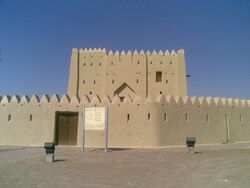Social:Rumailah, UAE
ٱلرُّمَيْلَة | |
 Al-Rumailah Fort | |
| Location | Al Ain, Eastern Region of the Emirate of Abu Dhabi, the UAE |
|---|---|
| Region | Tawam |
| Coordinates | [ ⚑ ] : 24°16′37″N 55°45′32″E / 24.27694°N 55.75889°E |
| Type | Settlement |
| History | |
| Founded | c. 1,100-500 BCE[1][2] |
| Cultures | Umm Al-Nar[1][2] |
| Site notes | |
| Condition | Ruined |
| Ownership | Public |
| Public access | Yes |
Rumailah (Arabic: ٱلرٌّمَيْلَة) is an archaeological site in Al Ain, UAE,[1] as well as the site of a thick-walled coral and adobe fort, thought to date to the early 20th century.[3]
Located three kilometres west of Hili Archaeological Park, the rectangular mound at Rumailah is thought to have been home to populations dating back to the late Umm Al-Nar period, yielding buildings and artefacts from a more recent, major Iron Age II settlement dated from around 1,100-500 BCE.[1][2]
Finds
Finds at Rumailah include distinctive pottery adorned with snake patterns, similar to finds at Qusais, Masafi and the major Iron and Bronze Ages; metallurgical production centre at Saruq Al Hadid, as well as chlorite vessels decorated with turtles alternating with trees, similar to finds from Qidfa' in Fujairah, Qusais in Dubai and Al-Hajar in Bahrain. A number of Iron Age swords and axe-heads, as well as distinctive seal moulds, were also recovered from the site. A number of bronze arrowheads were also found at the site. The Iron Age buildings found at Rumailah are typical of those found in the region, at Iron Age I and II sites such as Al Thuqeibah and Muweilah, with a number of row dwellings, although lacking the perimeter walls found at Thuqeibah.[4] A columned hall at Rumailah provides a further link to Muwailah, while a number of pyramidal seals found at Rumailah find an echo with similar objects discovered at Bidaa bint Saud.[2]
See also
- List of Ancient Settlements in the UAE
- Al-Buraimi
- Bidaa Bint Saud
- Ibri
- Qattara Oasis
References
- ↑ 1.0 1.1 1.2 1.3 Salama, Samir (2011-12-30). "Al Ain bears evidence of a culture's ability to adapt". Gulf News. https://gulfnews.com/news/uae/culture/al-ain-bears-evidence-of-a-culture-s-ability-to-adapt-1.958876.
- ↑ 2.0 2.1 2.2 2.3 Potts, Daniel T.; Nābūdah, Ḥasan Muḥammad; Hellyer, Peter (2003). Archaeology of the United Arab Emirates. London: Trident Press. p. 188. ISBN 190072488X. OCLC 54405078. https://www.worldcat.org/oclc/54405078.
- ↑ User, Super. "Castles.nl - Al Rumailah Fort" (in nl-nl). http://www.castles.nl/rumailah-fort.
- ↑ Potts, Daniel T.; Nābūdah, Ḥasan Muḥammad; Hellyer, Peter (2003). Archaeology of the United Arab Emirates. London: Trident Press. pp. 174–177. ISBN 1-9007-2488-X. OCLC 54405078. https://www.worldcat.org/oclc/54405078.
 |

